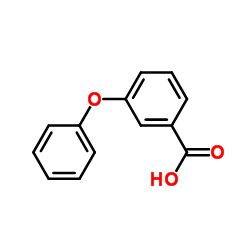3-Phenoxybenzoic acid

3-Phenoxybenzoic acid structure
|
Common Name | 3-Phenoxybenzoic acid | ||
|---|---|---|---|---|
| CAS Number | 3739-38-6 | Molecular Weight | 214.217 | |
| Density | 1.2±0.1 g/cm3 | Boiling Point | 372.9±25.0 °C at 760 mmHg | |
| Molecular Formula | C13H10O3 | Melting Point | 147-149 °C(lit.) | |
| MSDS | Chinese USA | Flash Point | 145.7±16.7 °C | |
| Symbol |


GHS07, GHS09 |
Signal Word | Warning | |
|
Perturbation of rat heart plasma membrane fluidity due to metabolites of permethrin insecticide.
Cardiovasc. Toxicol. 11(3) , 226-34, (2011) Due to increased global use, acute and chronic exposures to pyrethroid insecticides in humans are of clinical concern. Pyrethroids have a primary mode of action that involves interference with the sodium and calcium channels in excitable cells, which may incl... |
|
|
Degradation of 3-phenoxybenzoic acid by a Bacillus sp.
PLoS ONE 7(11) , e50456, (2012) 3-Phenoxybenzoic acid (3-PBA) is of great environmental concern with regards to endocrine disrupting activity and widespread occurrence in water and soil, yet little is known about microbial degradation in contaminated regions. We report here that a new bacte... |
|
|
The central role of mosquito cytochrome P450 CYP6Zs in insecticide detoxification revealed by functional expression and structural modelling.
Biochem. J. 455(1) , 75-85, (2013) The resistance of mosquitoes to chemical insecticides is threatening vector control programmes worldwide. Cytochrome P450 monooxygenases (CYPs) are known to play a major role in insecticide resistance, allowing resistant insects to metabolize insecticides at ... |
|
|
Degradation of selected agrochemicals by the white rot fungus Trametes versicolor.
Sci. Total Environ. 500-501 , 235-42, (2014) Use of agrochemicals is a worldwide practice that exerts an important effect on the environment; therefore the search of approaches for the elimination of such pollutants should be encouraged. The degradation of the insecticides imiprothrin (IP) and cypermeth... |
|
|
Examination of caspase-dependent apoptotic and necrotic changes in rat kidney exposed to different doses of permethrin.
Biotech. Histochem. 88(2) , 76-85, (2013) We investigated dose-related pathological alterations and apoptosis in rat kidney tissue exposed to permethrin. Histopathological findings, apoptotic cell death and urinary 3-phenoxybenzoic acid concentrations (3-PBA) were evaluated. Different doses of permet... |
|
|
Uptake and elimination of permethrin related to the use of permethrin treated clothing for forestry workers.
Toxicol. Lett. 231(2) , 147-53, (2014) Wearing of permethrin treated clothing usually implicates an uptake of permethrin by the user. Aim of our study was to examine the kinetics of internal permethrin exposure in volunteers during and after a single 8h-use of treated clothing as well as factors p... |
|
|
Effects of early life permethrin exposure on spatial working memory and on monoamine levels in different brain areas of pre-senescent rats.
Toxicology 303 , 162-8, (2013) Pesticide exposure during brain development could represent an important risk factor for the onset of neurodegenerative diseases. Previous studies investigated the effect of permethrin (PERM) administered at 34 mg/kg, a dose close to the no observable adverse... |
|
|
Identification and characterisation of Aedes aegypti aldehyde dehydrogenases involved in pyrethroid metabolism.
PLoS ONE 9(7) , e102746, (2014) Pyrethroid insecticides, especially permethrin and deltamethrin, have been used extensively worldwide for mosquito control. However, insecticide resistance can spread through a population very rapidly under strong selection pressure from insecticide use. The ... |
|
|
Nonsteroidal anti-inflammatory drugs and their analogues as inhibitors of aldo-keto reductase AKR1C3: new lead compounds for the development of anticancer agents.
Bioorg. Med. Chem. Lett. 15 , 5170-5, (2005) Nonsteroidal anti-inflammatory drugs (NSAIDs) like indomethacin, flufenamic acid, and related compounds have been recently identified as potent inhibitors of AKR1C3. We report that some other NSAIDs (diclofenac and naproxen) also inhibit AKR1C3, with the IC(5... |
|
|
Bacterial community analysis of cypermethrin enrichment cultures and bioremediation of cypermethrin contaminated soils.
J. Basic Microbiol. 55 , 819-29, (2015) Cypermethrin is widely used for insect control; however, its toxicity toward aquatic life requires its complete removal from contaminated areas where the natural degradation ability of microbes can be utilized. Agricultural soil with extensive history of CM a... |